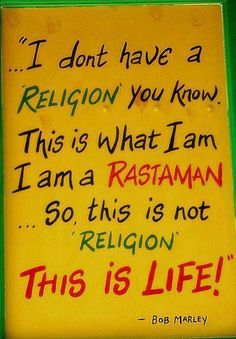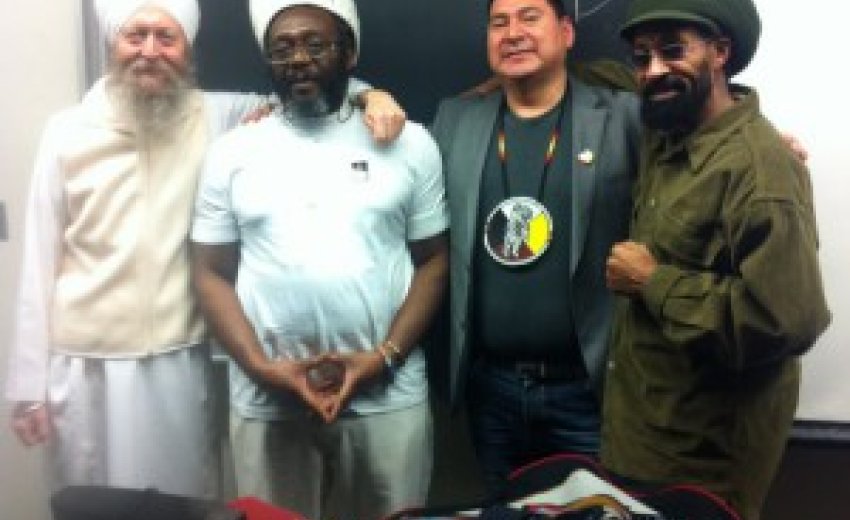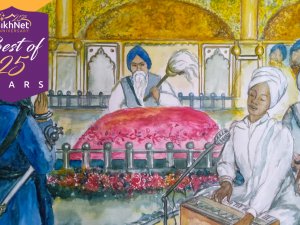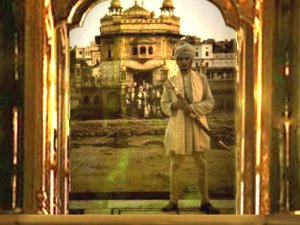What We Share
It is in our nature to take pride in Sikh dharma's unique and distinctive attributes, and to honour the sacrifices that have been made and continue to be made to preserve its integrity. The names of Bhai Mani Singh, Bhai Taru Singh and Baba Deep Singh live large in our creative imagination. It is understandable that as members of a community surrounded by much larger and influential communities, we should focus on our own unique circumstances, what makes us different, and the importance of those differences.
Sometimes it is worthwhile, however, to treat members of other communities as sisters and brothers with whom we also share values and experiences. Here in Canada, during an election campaign, it is not unusual for people of many diverse communities to campaign together for a single party or candidate to represent everyone's interests. It is through respectful, multicultural engagement that a number of members of visible minorities are elected to Parliament, sometimes even in places where their communities may be few in number. Today, under its system of representative democracy, people of every skin colour and almost every religion serve the needs and aspirations of all Canadians in its Parliament. This is the spirit of Sarbat da Bhalla.
 |
| Slate of University of Toronto Student Council Candidates including Malkeet Kaur (far right) |
It can be refreshing to reach out to another community, even a group considered a historical enemy for some common cause, as Sardarni Malkeet Kaur, co-chair of the Sikh Students Association (SSA) at the University of Toronto, did when she recently proposed to the Muslim Students Association that the two organizations collaborate for a well-publicized soccer game. The point of the exercise would be to show support to Sikh and Muslim athletes alike who have been deterred from playing their sports because of prejudices against their respective head covers. Once the snow clears and spring returns here, anyone interested will be able to see for themselves that turbans and hijabs are no hindrance to a good spirited game of soccer or volleyball.
In the interest of bridging religious boundaries, the SSA also recently hosted an event focused on the theme of peoples that keep, or historically have kept, naturally long hair. On this theme, our guest presenters were local members of the Rastafarian and Indigenous communities. With a bit of research, we were also able to explore the stories of other nations and groups who kept their hair uncut.
As the organizer of this event, I found it challenging to locate women presenters for the Rastas and First Nations. In the end, the only female speaker was our own Sardarni Ridhi Kaur. It was also not easy to find an Indigenous speaker with a traditional braid of long hair. Why this was so became painfully clear as Bear Standing Tall, who graciously accepted our invitation, told us the history of missionary boarding schools in North America and their horrific legacy of assimilating First Nations children into the newly predominant European culture. When Indigenous students arrived at these schools, the first thing their schoolmasters did was to cut their hair short. They were also forbidden to speak in their mother tongues.
| Divine Hair event photo - (left to right) - The author, Ras Jayant, Bear Standing Tall and Ras Sunray |
Before his presentation, Bear Standing Tall privately told me that his grandparents had themselves cut his hair before sending him to missionary school to spare him the trauma of having unkind strangers do the deed. On a positive note, our guest also proudly related for us all how Indigenous youth in Canada today are relearning their traditional cultures and languages, and how there is a growing movement among young people to reclaim their braids of sacred long hair. As missionaries had traversed the globe, inflicting their brand of religion wherever they went, Punjab not excepted, all of us in attendance readily sympathized with our dignified guest, Bear Standing Tall and his people.
Our Rastafarian guests came with abundant locks of matted hair barely concealed beneath their large, knitted cotton caps. Ras Jayant and Ras Sunray together presented the history of their faith, beginning in Jamaica in the 1930s. When oppressed Black people there came to hear of the enthronement of Haile Selassie, emperor of Ethiopia, they adopted him as their spiritual leader. During the Italian occupation of that country, when Selassie was deposed, the people of Ethiopia protested by letting their hair grow out, and Rastafarians in the West followed suit.
 In time, the Rasta people developed a lifestyle based on respectful relationships with nature and one another. Rasta men came to call Rastafarian women "Empress" and "Sister." They also began to pursue a vegetarian, saltless diet, and to keep their distinctive hair and beards. As our guests explained, keeping their long hair meant they were often targeted by police and others, who treated them as social outcastes, but oppression only made them pull closer together. Over time, music came to play an important part in Rastfarian culture. After Haile Selassie, the most depicted person among the Rastas is Bob Marley, the famous musician. Having a few kirtaniya in our group, there was a general appreciation of the importance of spiritual music in the lives of the Rastafarians.
In time, the Rasta people developed a lifestyle based on respectful relationships with nature and one another. Rasta men came to call Rastafarian women "Empress" and "Sister." They also began to pursue a vegetarian, saltless diet, and to keep their distinctive hair and beards. As our guests explained, keeping their long hair meant they were often targeted by police and others, who treated them as social outcastes, but oppression only made them pull closer together. Over time, music came to play an important part in Rastfarian culture. After Haile Selassie, the most depicted person among the Rastas is Bob Marley, the famous musician. Having a few kirtaniya in our group, there was a general appreciation of the importance of spiritual music in the lives of the Rastafarians.
Most members of our gathering were unaware of the extent to which long hair has been accepted and embraced in cultures around the world through history. For many thousands of years, it was customary in China and Korea to keep one's hair in a topknot on one's head. The great sages of Chinese philosophy, Confucius and Lao-tse, both taught the wisdom of keeping one's body in its natural state without cutting, tattooing or circumcising it. While Confucius considered keeping the body inviolate as a form of respect to parents and ancestors from whom one inherited it, Lao-tse encouraged his followers to treat their body as a holistic system and to appreciate the natural flow of life force within it.
While Buddhism, which taught renunciation of this world and shaving the head, made limited inroads in Chinese society about 2,000 years ago, the Manchu conquest of Ming China in 1644 marked the beginning of the end for the traditional custom of keeping the body intact and unshorn. The Manchus established garrison towns throughout the country and ordered that all males shave their foreheads and tie their remaining hair in a braid. It is estimated that hundreds of thousands of people, entire cities, were put to death for defying the Manchu order.
The arrival from Europe of missionaries, and then Communism, took the Chinese people even further away from their traditional customs. Under Communist rule during the 1960s and 1980s, anyone with long hair was branded a counter-revolutionary and sent to a "re-education camp." Surprisingly, in China today Confucianism is being revived to a limited extent and Taoism is also being practised once again.
In ancient Greece, men are believed to have kept topknots and beards up until about 600 BCE. The big change came with Alexander the Macedonian conqueror, who ordered his armies to shave off their beards so opponents could no longer take told of them in battle. Not everyone appreciated the advantage to the Greeks. The philosopher Diogenes, who is famously said to have walked the streets of Corinth looking for an honest man, approached fashionably shaven young men and challenged them, "Have you shaved because you are disappointed you were created a man instead of a woman?"
In the territory we now speak of as "France," the historic Frankish peoples prided themselves on their long hair and beards. Their laws reflected this. For fracturing a person's rib, one would pay a fine of 3 shillings. The loss of a front tooth was assessed at 6 shillings. A broken thigh called for a fine of 12, but the loss of a beard counted for a hefty fine of 20 shillings. When the Romans conquered the Franks, they ordered the hair of their new subjects cut off.
The tradition that Jesus of Nazareth was longhaired and bearded lives on even today. When the Western Church, proud of its Roman culture, insisted priests cut their hair to "a moderate length" in 456 to distinguish them from so-called "hairy barbarians," many refused the order. That edict needed to be repeated in 506, 572, 721, and again in 743, each time threatening disobedient priests with expulsion from the Church.
Eastern Christians, on the other hand, found the example of the unshaven Jesus appealing, and their priests largely followed his example through the centuries. Only Patriarch Nikon (1651-1658) tried to put an end to the practice to align Russian Christians with the West. The barefaced Tsar Peter I (1682-25) subsequently taxed Russian beards as one of his many schemes to "modernize" Russia.
Swamis and yogis brought their longhaired culture to North America and Europe in the 1960s. Famous among them were Maharishi Mahesh Yogi, Swami Satchidananda and Yogi Bhajan. The Maharishi achieved fame through his propagation of Transcendental Meditation, while the Swami did the opening blessing for the historic Woodstock music festival in 1969. Arriving in Toronto in 1968, turbaned Yogi Bhajan founded the Healthy, Happy, Holy Organization and spread Sikh values, while befriending spiritual people and humanitarians of all denominations.
We concluded our event with an appreciation of the longhaired hippies of the 1960s. The so-called "flower children" had a large influence on the culture of their time and generations to come. They pioneered ecological living, racial equality, social activism, feminism, anti-war efforts, yoga, meditation, and early computer culture in the West. Their exuberant energies live on in the musical Hair (1967), while the angst of that time is epitomized in the song Almost Cut My Hair (1970).
As Sikhs, we cherish our hair. As humans, it is reflected in our DNA as part of our essential nature. We recognize it as a gift from our Creator. Worn long and beturbanned, it makes us stand out. But we are not alone in our love of hair. By educating ourselves about the stories of our neighbours and nations that have come before us, we can see that while our fight to maintain our distinctive identity is noble, it is hardly unique. Through history, many brave souls have fought and suffered for the right to maintain their God-given, crowning glory. Entire civilizations have proudly preserved their hair. Some of our neighbours even today struggle with identity issues tied to their hair just as we do.
An important lesson of the Divine Hair event at the University of Toronto this past month was that respecting our own culture does not preclude honouring and understanding others' traditions. Rather, by recognizing points of commonality and difference, we may broaden our circle of engagement and our circle of concern, our true consciousness of Sarbat da Bhalla. By telling our story and respectfully hearing the stories of others, we become a little deeper, a bit more broad-minded, and I believe a better Sikh of our great Guru Nanak Dev, teacher of the world.





